Download Pdf [4,89 MB] - MTU Aero Engines
Download Pdf [4,89 MB] - MTU Aero Engines
Download Pdf [4,89 MB] - MTU Aero Engines
You also want an ePaper? Increase the reach of your titles
YUMPU automatically turns print PDFs into web optimized ePapers that Google loves.
Technology + Science<br />
Next-generation engines –<br />
quieter and thriftier<br />
By Martina Vollmuth<br />
Commercial aviation is riding a fast growth track: industry experts see air traffic doubling by 2020. To contain the<br />
environmental toll this stellar growth will take, the industry is working on thriftier, quieter and cleaner aircraft. The<br />
Advisory Committee for <strong>Aero</strong>nautics Research in Europe (ACARE) wants airliners by 2020 to burn 50 percent less<br />
fuel per passenger mile. A daunting challenge indeed, and companies like <strong>MTU</strong> <strong>Aero</strong> <strong>Engines</strong> have for years been honing<br />
new technologies to meet it.<br />
The target is ambitious: ACARE wants commercial<br />
jets not just to consume less fuel, it<br />
moreover mandates noise to be halved and<br />
emissions slashed 80 percent, from present<br />
levels. “<strong>Engines</strong> will have to bear the brunt<br />
of it,” explains Dr. Günter Wilfert, a technology<br />
strategist at <strong>MTU</strong>. Their fuel consumption<br />
will have to come down 20 percent,<br />
noise levels six decibels and oxides of nitrogen<br />
emissions 80 percent.<br />
Engine builders have two alternative options<br />
to achieve improvements. “The one is to optimize<br />
existing propulsion concepts, and the<br />
other is to develop entirely new technologies,”<br />
explains Prof. Dr. Klaus Broichhausen,<br />
chairman of the newly founded Bauhaus<br />
Luftfahrt think tank. Optimizing means that<br />
technologists and researchers dissect components—compressors,<br />
combustors and turbines—to<br />
see where they might be able to<br />
squeeze out improvements. As a rule of<br />
thumb, if you raise the efficiency of a component<br />
by one percent, you reduce fuel consumption<br />
by up to one percent. In<br />
Broichhausen’s estimation, tweaking the<br />
core components—high-pressure compressor,<br />
combustor and high-pressure turbine—<br />
gets you a fuel reduction margin of totally<br />
two to three percent, while optimizing a fan<br />
or low-pressure compressor and low-pressure<br />
turbine will net you three to four percent.<br />
Improvements can be achieved also by the<br />
way engines are operated. Today’s aircraft<br />
engines are not just delivering thrust but<br />
electrical power as well, providing the airframe<br />
with current to energize the air conditioning<br />
system, onboard electronics and<br />
hydraulic systems. Says Broichhausen: “If<br />
you relieve the engine of these auxiliary<br />
tasks, you could trim it down to the basics,<br />
making it thriftier.” The power supply for the<br />
airframe could then be provided by a standalone<br />
power generator, and the engine could<br />
be electrified. Substituting hydraulic components<br />
with electrically actuated equipment,<br />
too, would save five to seven percent fuel.<br />
The turbine center frame has a major impact on the<br />
engine’s overall efficiency. Its design, therefore,<br />
demands painstaking care.<br />
10 REPORT REPORT 11


![Download Pdf [4,89 MB] - MTU Aero Engines](https://img.yumpu.com/5322947/6/500x640/download-pdf-489-mb-mtu-aero-engines.jpg)


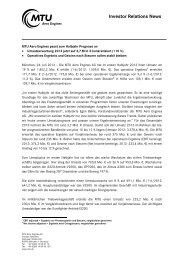
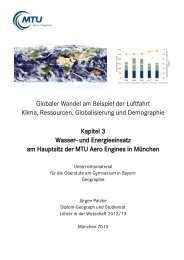
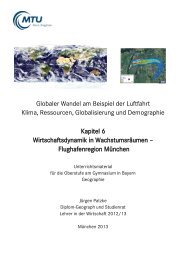
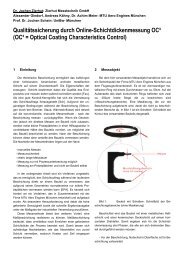
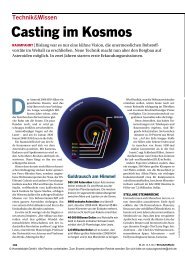

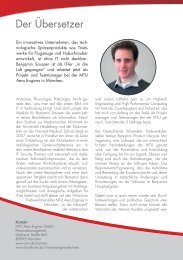
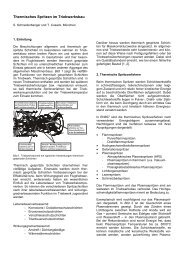
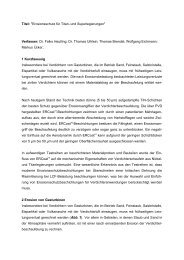


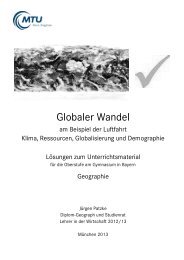
![Download PDF [5,37 MB] - MTU Aero Engines](https://img.yumpu.com/21945461/1/190x125/download-pdf-537-mb-mtu-aero-engines.jpg?quality=85)